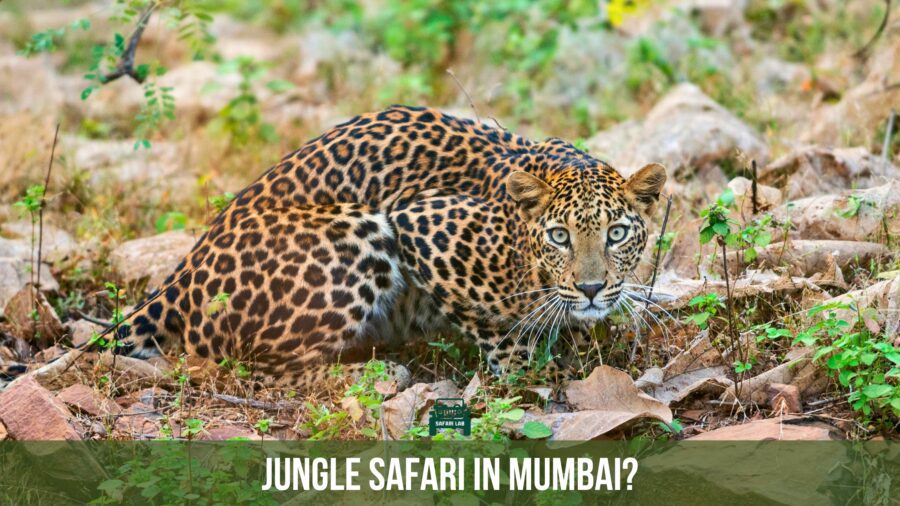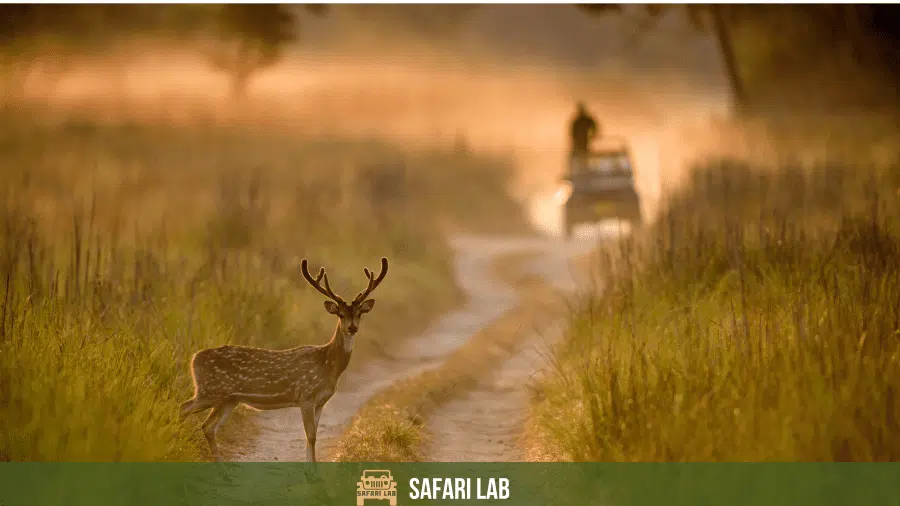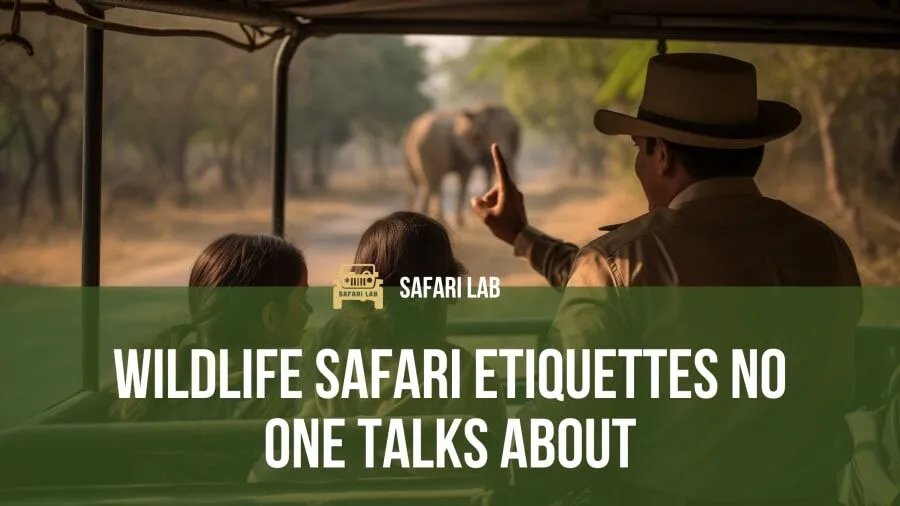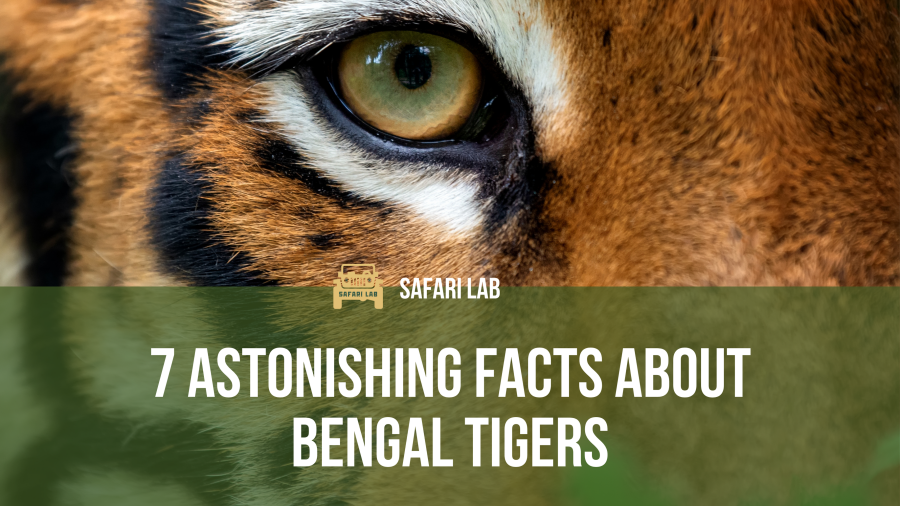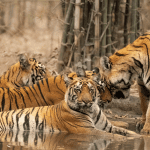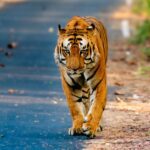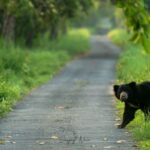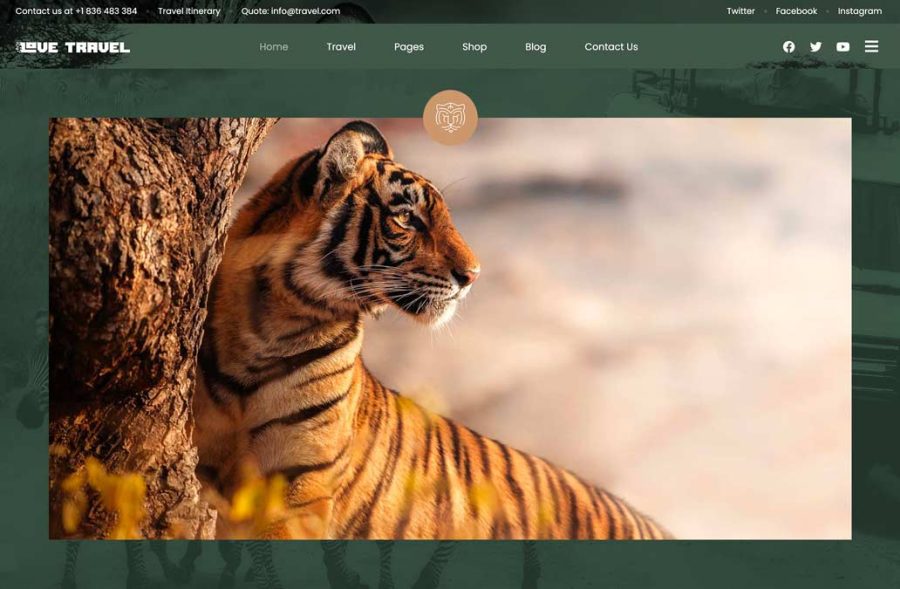Jungle safari in Mumbai may sound like a contradiction, but hidden in the city’s green lung, the Sanjay Gandhi National Park, nature flourishes against all odds. In the restless sprawl of Mumbai, where honking horns and human hustle set the rhythm of daily life, this is a secret, breathing wilderness — a place where nature still reigns supreme.
Here, tangled forests cradle leopards that pad silently through the undergrowth, and chital deer graze in dappled sunlight as if the metropolis beyond does not exist.
In this remarkable refuge, where mangroves and ancient woodlands embrace a staggering diversity of life, the heartbeat of the wild endures — even in the shadow of skyscrapers.
If you have always wondered whether the occassional media story of a wild leopard being spotted in the city is just a myth or reality, sit back and enjoy this read as we decode the jungle safari in Mumbai for you.
Can You Do a Jungle Safari in Mumbai?
To the north of Mumbai’s glass towers and crowded streets, there exists a green sanctuary that defies the relentless march of urbanity. Sanjay Gandhi National Park, or SGNP as locals fondly call it, is the beating heart of Mumbai’s wild side.
Covering more than a hundred square kilometres, this remarkable expanse of forest clings to life within the pressure of India’s most densely populated metropolis. And yet, it thrives.
A jungle safari here is not merely an outing — it is a portal into an ancient ecosystem that has persisted since before the city’s first railway ran. From thickly wooded slopes to sun-dappled meadows, this is where leopards still roam, unbowed by the human tide beyond the park’s boundary.
Here, the forest reveals a world where chital deer graze in gentle herds, where langurs launch their acrobatics from banyan to fig, and where the alarm call of a sambar deer can send a shiver through the undergrowth.
This, then, is Mumbai’s own window into the wild — a true jungle safari, hemmed in by steel and concrete yet defiant in its wilderness.
What Can You See on a Jungle Safari in Mumbai?
Step into Sanjay Gandhi National Park, and you step into a realm where nature’s drama unfolds with astonishing grace. Here, the forest is alive with secrets.
You may glimpse a leopard gliding through the tall grass, its spotted coat melting effortlessly into the dappled shade, its amber eyes reflecting centuries of quiet dominion. Herds of chital deer wander across sunlit clearings, their white-spotted flanks blending beautifully with shafts of morning light.
Look closer, and you will see sambar deer, far larger and more cautious, picking their way through tangled vines. Gray langurs, ever the mischief-makers, chatter among the branches, leaping with such ease it seems they are weightless.
From the treetops comes the fluting cry of peafowl, while eagles circle above, scanning the grassland for an unwary rodent.
Kingfishers dart like jewels over the surface, snatching fish in a flash of brilliance.
And if you stand still, listening, you might even hear the distant alarm call that signals a predator’s approach — a sound that sends ripples through the entire forest.
It is, in every way, a living testament to nature’s resilience, playing out against the impossible backdrop of one of the world’s busiest cities.
However, we must mention that there is no open gypsy safari in Mumbai, like the national parks in the rest of the country. All you can do here is set off on walking trails deep in the woods, an experience that’s more raw and grounded in our opinion. But wait, there’s more.
What if you could spot the big cat in Mumbai city?
Tiger Safari in Mumbai
In a move straight out of a wildlife resurgence story, Sanjay Gandhi National Park hosts a tiger safari within a secure, fenced enclosure. This isn’t a wild-forest sighting—it’s a carefully managed and safe window into big-cat conservation.
And here’s the latest roar-worthy update: three new tiger cubs, born to tigress Srivalli (T24‑C2), made their debut on 24 June 2025 in the safari enclosure.
Healthy, playful, and already stealing hearts, these cubs provide a rare—and much-needed—boost to both conservation efforts and public engagement.
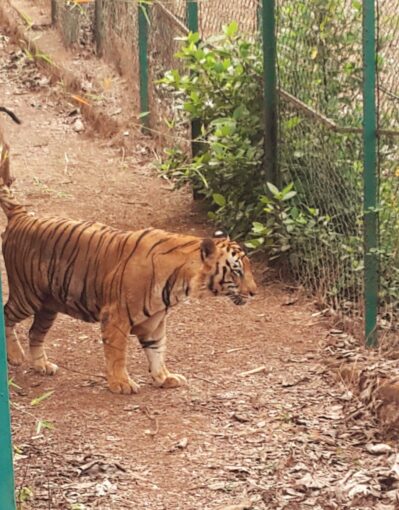
Creative Commons
Visitors board secure mini‑buses that wind through the enclosure, bringing them within feet of these majestic creatures—while ensuring both human and tiger safety.
The experience treads the fine balance between immersion and protection, a little city‑based glimpse into tiger conservation. The tiger is not the sole big cat you can spot in the SGNP.
Lion Safari in Mumbai
Not far from the tiger enclosure, the Sanjay Gandhi National Park also shelters a pride of lions, housed within their own separate safari area.
These lions are descendants of Asiatic Lions, animals that once roamed freely across much of India before retreating to the final stronghold of Gir.
The lion safari here began in the 1970s as a bold attempt to reconnect Mumbai’s people with the subcontinent’s most storied predator.
These majestic animals have since been relocated and renewed via exchanges with Gujarat’s Sakkarbaug Zoo.
Today, the lion enclosure spans roughly one acre—fenced, yet spacious enough to mimic a semblance of natural habitat. Visitors glide through in mini‑buses, looking out at lions lounging, prowling, even occasionally roaring.
The experience remains controlled and educational, part sanctuary, part conservation showcase.
Within the fenced boundaries of this enclosure, the lions move through a mixture of open glades and shaded trees, their heavy bodies gliding with a grace that belies their power.
Guests are brought in on protected buses, rolling quietly through the heart of the lions’ territory. One might glimpse a lion stretched out in the sun, massive paws curled in rest, or see a lioness scanning the treeline for a sign of movement, her ears pricked in the hush of the afternoon.
Though these animals do not roam the true wilds of Maharashtra, they are ambassadors of their kind, offering city dwellers the chance to look into the golden eyes of the king of beasts without ever leaving the city. Here, in this curated wilderness, the lion’s roar still echoes among Mumbai’s ancient hills.
Leopard Safari in Mumbai
If there is a big cat that embodies the spirit of Mumbai, it is the leopard. Sly, shy, adaptive, secretive, the leopard reflects the sheer resilience that the city is renowned for.
Now, in a development that feels like stepping deeper into the wild heart of the city, Sanjay Gandhi National Park is preparing to launch its first-ever leopard safari enclosure.
Picture this: a 30‑hectare sanctuary, meticulously crafted within the forest’s embrace, designed to mimic the leopard’s natural environment—shaded groves, rocky outcrops, and hidden dens. This is not about spotting these rare cats at the edge of a road; it’s about immersing yourself in their world.
Announced in early 2025 by Maharashtra’s minister Ashish Shelar, the project carries a price tag of around ₹5 crore, funded jointly by the Forest Department and district planning committee.
The aim is twofold: to provide a safe and enriching home for rescued and rehabilitated leopards—currently numbering about 17 and expected to grow—and to offer visitors a controlled yet visceral safari experience
Officials have already applied to the Central Zoo Authority to green-light the venture, targeting an opening in roughly 18 months from inception. When you board a secure safari vehicle, you won’t just see a leopard—you’ll sense them. They may be lounging on elevated rocks, slinking up trees, or chasing one another in playful bursts, all while surrounded by habitat that breathes wild authenticity.
Beyond the thrill, this initiative is a powerful educational tool. It aims to dispel fear around these elusive predators, highlighting their crucial ecological role and fostering human–wildlife coexistence—especially significant as leopards increasingly appear in suburban zones like Aarey Colony.
The leopard safari enclosure promises to be a turning point—a rare glimpse into Mumbai’s untamed side, where conservation and experience stride together under the forest canopy.
In the Sanjay Gandhi national park, are animals in enclosures, or Do They Roam Freely?
One of the most remarkable truths of Sanjay Gandhi National Park is that it exists in two worlds at once. Here, in this living island of green, wild creatures truly do roam free.
Spotted deer move without restriction through the open forest, their hooves tapping a rhythm upon the sun‑dappled earth. Sambar, bulkier and more cautious, slip through dense stands of bamboo, ever wary of a shadow in the grass.
Troops of langurs launch themselves between branches, unconfined, their high calls echoing across the forest canopy.
Yet, there are other inhabitants who live within carefully defined boundaries.
The tiger and lion safaris are contained within strong, secure enclosures — sprawling and designed to echo the animals’ wild homes, but enclosed nonetheless. These enclosures, built for the protection of both humans and predators, ensure visitors can safely observe India’s great cats without fear, while the animals themselves are shielded from the chaos of the surrounding city.
In the coming months, the leopard safari will join this pattern: a controlled environment, giving these elusive felines a sanctuary of their own, where they can be seen and understood without the risk of conflict.
So it is, in this curious balancing act, that Sanjay Gandhi National Park tells two stories. One is of creatures who still wander freely under the open sky, living their ancient lives with little regard for the nearby highways and apartment towers.
The other is of powerful, threatened predators, held within safe boundaries where they might inspire wonder and respect, while also reminding us of how delicate their place in the world has become.
Mumbai’s Wild Leopards: A Tale of Coexistence and Conservation
When you speak of a jungle safari in Mumbai, few images are as powerful — or as haunting — as that of a leopard gliding past high-rise apartments under the cover of night.
These moments, immortalised by legendary photographer Steve Winter, reveal an extraordinary truth: leopards not only survive, but thrive, right on the doorstep of India’s largest city.
His infrared camera traps, set along the borders of Sanjay Gandhi National Park, captured these big cats threading through the fringes of apartment blocks, a remarkable testament to adaptability and resilience.
Leopard Lives amid the Metropolis
Sanjay Gandhi National Park harbours an estimated 35 to 40 leopards within its modest 87 square kilometres of forest. These cats share space with more than 21 million human neighbours, yet manage a fragile balance that has lasted for decades.
Often, leopards slip out after dark into suburbs like Aarey, Borivali, Mulund, Yeoor or Powai, hunting easy prey such as stray dogs, pigs, or even goats — a risky but richly rewarding buffet in the city’s sprawl.
In an unexpected twist, their presence has been shown to help the city. Studies estimate that these leopards may kill between 800 and 2,000 stray dogs every year, indirectly preventing dozens of potential human rabies cases.
In a way, they perform an ecological service, controlling feral dog populations that the city has struggled to manage on its own.
Steve Winter’s Contributions
Steve Winter’s work, in collaboration with conservationists and published widely through National Geographic, brought global attention to these urban predators.
One unforgettable image shows a pair of leopard cubs on a ridge, Mumbai’s neon skyline blazing behind them — a visual paradox that captures the essence of wildness surviving at the very edge of human civilisation.
His camera traps revealed that these big cats were far from shy; they navigated streets, temple steps, even garbage dumps with the steady confidence of animals that had adapted to this curious half-forest, half-city world.
Challenges and Coexistence
Of course, the relationship is not without its tensions. There have been tragic leopard attacks in areas where human settlements overlap too closely with leopard territory, reminders of just how delicate coexistence can be.
Yet experts like Vidya Athreya and others believe that peaceful coexistence is both possible and necessary.
Community awareness programmes now teach residents how to store food waste securely, avoid feeding stray animals, and move cautiously at night — all measures that respect the leopards’ presence while keeping people safe.
Steve Winter’s images do more than simply astonish; they ask us to rethink what it means to live beside the wild. In a city of glass towers and relentless traffic, these leopards continue to slip through the shadows, unbowed, reminding us that the pulse of the jungle still beats in Mumbai’s heart.
Where Can You Experience a True Wildlife Safari Near Mumbai?
There comes a moment, even in the green refuge of Sanjay Gandhi National Park, when one’s spirit aches for a wilder wilderness — a place where the forest stretches without fences, and the great beasts rule entirely on their own terms.
For those who dream of tigers melting through the bamboo, or flocks of flamingos lighting the sky in shades of coral and rose, the world beyond Mumbai’s boundaries offers a feast for the senses.
Here, scattered across Maharashtra and Gujarat, lie some of the subcontinent’s finest wildlife havens, each within striking distance of the city.
From the wetlands that blaze pink with migratory birds to deep forests echoing with the roars of the tiger, these sanctuaries promise an authentic, untamed safari, where you are merely a respectful guest in the kingdom of the wild.
Let us travel now, in both mind and map, to these extraordinary realms.
Bhigwan: The Bharatpur of Maharashtra
To the southeast of Mumbai, at a distance of approximately 250 kilometers, lies Bhigwan, a wetland wonderland often compared to Bharatpur for its spectacular birdlife. But the secret that seasoned wilderness lovers whisper about is far richer: Bhigwan’s grasslands and sugarcane fringes are home to packs of Indian grey wolves and, occasionally, hyenas — predators roaming freely beyond Ujani Dam’s backwaters.
Wolves here are not fenced exhibits but wild inhabitants of the landscape, moving in small packs of six to eight, hunting hares, rodents, and even smaller ungulates at dawn and dusk. Thrill-seekers can set out on guided grassland safaris into sugarcane fields, sometimes tracing the elusive grey figures emerging from the morning mist.
These wolf-tracking safaris often carry explorers 50 kilometers beyond Bhigwan, toward Walchandnagar, into remote, rolling grasslands where a silent, cautious shape slipping through the scrub might well be a wolf.
Of course, the wild here is not tame. The wolves share their kingdom with jackals, foxes, hyenas, hares, countless bird species, and fish-rich wetlands — all woven into a vibrant ecosystem shaped by water and land. The local community, from boatmen to wildlife trackers, treats these predators with caution and reverence, knowing that respect achieves far more than fear.
Bhigwan teaches us that a safari’s magic often lies in stillness — watching wolves vanish into cane, listening to their distant howls, and feeling the pulse of life beyond the flamingo flocks.
Koyna Tiger Reserve: The Fortress of the Sahyadris
Some 290 kilometers from Mumbai, in the rugged embrace of the Western Ghats, Koyna Tiger Reserve stands as a formidable stronghold of Maharashtra’s wilderness. Here, the Sahyadris rise and fold in dramatic waves of evergreen forest, crisscrossed by countless streams that tumble from hidden springs.
This is a land where nature still rules, and where the tiger — silent, watchful, and magnificent — reigns as undisputed monarch of the shadows.
Koyna forms a part of the larger Sahyadri Tiger Reserve, sharing its landscape with Chandoli Wildlife Sanctuary to the south. Within its deep green reaches, the forest hosts a thriving population of tigers, leopards, sloth bears, wild boar, sambar, and barking deer. Gaur — the colossal Indian bison — roam the clearings, their massive frames cutting through the misty dawn. Langurs and bonnet macaques chatter in the treetops, ever alert to the presence of predators stalking below.
Koyna’s greatest magic lies in its sense of seclusion. Unlike more commercialized parks, it is a world apart — quiet, rugged, and gloriously raw, where the only sounds are cicadas singing and the call of a distant hornbill drifting through the canopy. Forest guards, whose knowledge runs as deep as the roots of these ancient trees, guide small groups through this fortress of green, revealing glimpses of a world where tigers and black panthers still shape the rhythm of the wild.
Tadoba Tiger Reserve: Maharashtra’s Tiger Kingdom
Far to the east of Mumbai, beyond the basalt hills and monsoon-sculpted plateaus, lies a land that breathes to the rhythm of the tiger’s roar. Tadoba-Andhari Tiger Reserve, nearly 840 kilometers from Mumbai in Chandrapur district, is not merely a wildlife park — it is the premier tiger destination in Maharashtra, the beating heart of the state’s wilderness dreams.
Here, the tiger is not a phantom of the forest but a presence woven into every breeze and footprint. Massive teak and bamboo forests stretch across rolling plains, interspersed with sun-baked meadows and quiet lakes that mirror a sky shimmering with raptors. In this raw, unbroken landscape, the tiger moves as sovereign, unchallenged and glorious, commanding respect that borders on reverence.
Tadoba’s reputation is hard-earned. Nowhere else in Maharashtra will you find so many tigers in such a concentrated realm — a place where their roars echo by dusk, where fresh pugmarks still wet from a waterhole send a ripple of electricity through every visitor.
This is the tiger’s kingdom. The forest here is theirs. We are, at best, polite guests, privileged to witness them on their own terms.
Gir Wildlife Sanctuary: The Last Refuge of the Asiatic Lion
Traveling roughly 800 kilometers northwest of Mumbai, beyond Gujarat’s dry thorn forests and rolling grasslands, you will find one of the subcontinent’s greatest conservation stories: Gir Wildlife Sanctuary, the final stronghold of the Asiatic lion. Nowhere else on Earth does this ancient bloodline still walk free, their history intertwined with human legends stretching back centuries.
Gir is a land of contrasts, where rugged hills spill into river valleys lined with teak and flame-of-the-forest. Herds of chital and sambar move through these woods with wary elegance, knowing that they share their world with a powerful predator whose presence can hush the land in an instant. The Asiatic lion, with its leaner build and distinctive fold of skin along the belly, rules these forests with a quiet, steady authority, unshaken by its shrinking domain.
For visitors, there is nothing quite like seeing a lion in Gir. Unlike the African savannahs, here you may catch sight of a lion reclining in the shade of a khair tree, or moving through a dry riverbed, its mane rippling like a dusky crown in the wind. They are closer to us than their African cousins, and somehow that intimacy — in a forest of peacocks, langurs, and nilgai — makes their survival even more precious.
It is a place where the drama of predator and prey still plays out every day, a testament to centuries of coexistence between lions and the resilient Maldhari pastoralists who share their homeland.
Gir’s fame rests with the lion, but its wilderness is far richer. Leopards stalk the edges of rocky outcrops, Indian foxes dart through the tall grasses, and striped hyenas clean up after the drama of the hunt. Marsh crocodiles glide through Kamleshwar Dam, eyes just breaking the water’s surface, while troops of langurs act as ever-watchful sentinels in the canopy.
The skies above are an avian treasure trove: crested serpent eagles, painted storks, paradise flycatchers, and the spectacular Indian eagle-owl. In the undergrowth, monitor lizards scuttle over sun-warmed stones, while mongooses search tirelessly for prey.
Melghat Tiger Reserve: The Wild Heart of the Satpuras
Around 650 kilometers from Mumbai, in the rugged folds of the Satpura hill ranges of northern Maharashtra, lies Melghat Tiger Reserve — a land where nature still hums with primal rhythms. Meaning “meeting of the ghats,” Melghat is a place of ravines, high ridges, and valleys dressed in dense dry deciduous forests, woven through with teak, bamboo, and flame-of-the-forest trees that burn with color every spring.
This is one of India’s earliest declared tiger reserves, and for good reason. Here, the tiger still moves with a sovereign calm through deep canyons and forested plateaus, a creature perfectly adapted to the raw, untamed landscape. The reserve is vast, extending over 1,600 square kilometers, and its sheer size lends the big cats a freedom rarely seen in more crowded parks. Their presence is felt rather than always seen, marked by pugmarks in the riverbed or the occasional distant roar rolling across the hills at dusk.
Melghat is as much about its mood as its megafauna — a wilderness that feels ancient and unchanged, a place where silence is punctuated only by the calls of langurs or the wind sighing through sal leaves. It is a sanctuary where humans remain small and respectful, grateful for the privilege of witnessing nature on its own terms.
FAQ on Jungle Safari in Mumbai
Q. Is there a jungle safari in Mumbai?
A. Yes — the best-known is at Sanjay Gandhi National Park (SGNP), located in Borivali. It has meandering forest trails and guided tours, along with tiger and lion safari enclosures where big cats live in secure, naturalistic habitats.
Can I see wild animals freely roaming in Mumbai?
Absolutely. Chital, sambar, langurs, monkeys, and even leopards roam freely within SGNP and nearby green areas like Aarey. The big cats in the lion and tiger enclosures, however, are in fenced safari zones.
Are there open gypsy safaris available in Mumbai?
No. Sanjay Gandhi National Park does not offer open-gypsy safaris. Instead, it provides covered, caged bus rides through its lion and tiger safari enclosures, and you can book guided tours in covered vehicles or join nature trails on foot for spotting other wildlife like deer and monkeys.
Can I see wild leopards in Mumbai?
Yes — but let’s be realistic. Spotting a wild leopard in Mumbai is extremely rare. These cats are masters of stealth, moving like living shadows through the forest and fringes of the city. Most sightings are sudden, blink-and-you-miss-it moments, typically glimpsed by early morning joggers, forest staff, or residents living near the park boundaries. While their presence is well documented through camera traps and occasional news stories, encountering a leopard in broad daylight is an experience reserved for the lucky few.
Is it safe to go on a jungle safari in Mumbai?
Yes. The SGNP safaris are well-regulated with trained drivers and forest guides. If you follow instructions and respect wildlife, the risk is minimal.
Where else near Mumbai can I go on a proper wildlife safari?
If you want a true, wild, big-cat safari, head to:
- Bhigwan (about 250 km) for flamingos and wolves
- Koyna Tiger Reserve (290 km) for tigers in the Sahyadris
- Tadoba Tiger Reserve (840 km) for Maharashtra’s richest tiger sightings
- Gir Wildlife Sanctuary (800 km) for Asiatic lions
- Melghat Tiger Reserve (650 km) for rugged Satpura wilderness
Conclusion: Listening for the Wild
In a city where the soundtrack is usually rickshaw horns and construction clatter, it is astonishing to realise that a leopard might be passing by, silent as a whisper, right within Mumbai’s Sanjay Gandhi National Park. This green sanctuary is the city’s own wild lung, offering a jungle safari experience unlike anywhere else in urban India.
But for those who yearn for the true wilderness — tiger landscapes stretching far and free, or lion kingdoms where the roar echoes for miles — destinations like Tadoba, Gir, Bhigwan, Melghat, and Koyna lie beyond Mumbai, scattered hundreds of kilometres away. These reserves, while not part of the city itself, are still accessible enough to draw adventurers from Mumbai who want to witness big cats and wild landscapes on a grander scale.
Whether you choose to marvel at flamingos at Bhigwan, track a tiger in Tadoba, or ride an open gypsy through Mumbai’s own forest trails, each of these experiences challenges us to respect the animals who share our world, often against impossible odds.
In the end, a jungle safari — whether it unfolds right in Mumbai or many kilometres beyond — is more than a wildlife checklist. It is a reminder that the wild is resilient, waiting for those willing to look with care, humility, and wonder.

